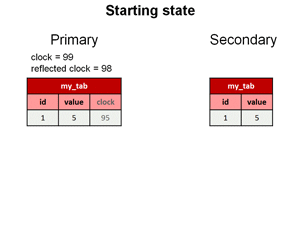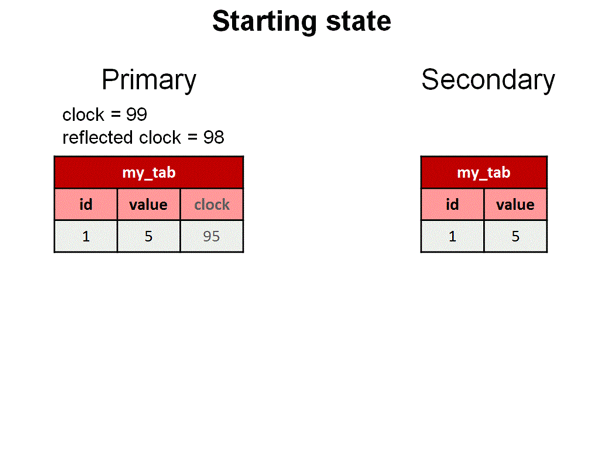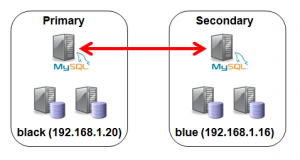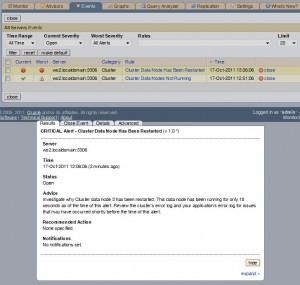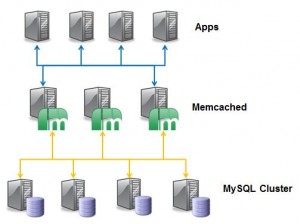 The MySQL Cluster 7.2 Development Milestone Release has been out for a while now and we’d love to hear which are your favourite features – it takes just a few seconds to complete the Quick-Poll. It should literally take seconds to complete and will provide us with valuable feedback on the kind of features are most useful – so that we can build more of them in the future!
The MySQL Cluster 7.2 Development Milestone Release has been out for a while now and we’d love to hear which are your favourite features – it takes just a few seconds to complete the Quick-Poll. It should literally take seconds to complete and will provide us with valuable feedback on the kind of features are most useful – so that we can build more of them in the future!
Tag Archive for MySQL Cluster 7.2
Chance to give your views on MySQL Cluster 7.2 content
Tweet
MySQL Cluster Evaluation Guide – refreshed for Cluster 7.2 DMR
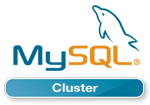 There is an updated version of the MySQL Cluster Evaluation Guide to go with the MySQL Cluster 7.2 Development Milestone Release.
There is an updated version of the MySQL Cluster Evaluation Guide to go with the MySQL Cluster 7.2 Development Milestone Release.
The purpose of this guide is to enable you to efficiently evaluate the MySQL
Cluster database and determine if it is the right choice for your application,
whether as part of a new project or an upgrade to an existing service.
This guide presents a brief overview of the MySQL Cluster database and new
features in the latest 7.2 Development Milestone Release, and then discusses:
- Considerations before initiating an evaluation
- Evaluation best practices
- Configuration options and sanity checking
- Troubleshooting
By following the recommendations in this Guide, you will be able to quickly and
effectively evaluate the MySQL Cluster 7.2 Development Milestone Release
(DMR).
Please note that the MySQL Cluster 7.2 Development Milestone is not a currently
production-ready release. It is published to provide a preview of new features that
are planned, but not committed, for the next production-ready “General
Availability” release of MySQL Cluster.
Tweet
Enhanced conflict resolution with MySQL Cluster active-active replication
Part of the latest MySQL Cluster Development Milestone Release (MySQL Cluster 7.2.1 – select the “Development Release” tab at http://dev.mysql.com/downloads/cluster/#downloads) is a couple of enhancements to the conflict detection and resolution mechanism for active-active (multi-master) replication. While MySQL Cluster has had conflict detection for years it has now been made much more complete and a lot easier to use:
- No changes needed to the application schema
- Entire conflicting transaction is rolled back together with any dependent transactions
The focus of this post will be to step through how to use this feature – while it will also attempt to explain how it works at a high level, you should refer to the following posts for the design details and philosophy: Eventual consistency with MySQL & Eventual Consistency – detecting conflicts.
What is a conflict?
MySQL Cluster allows bi-directional replication between two (or more) clusters. Replication within each cluster is synchronous but between clusters it is asynchronous which means the following scenario is possible:
| Site A | Replication | Site B |
|---|---|---|
| x == 10 | x == 10 | |
| x = 11 | x = 20 | |
| — x=11 –> | x == 11 | |
| x==20 | <– x=20 — |
In this example a value (column for a row in a table) is set to 11 on site A and the change is queued for replication to site B. In the mean time, an application sets the value to 20 on site B and that change is queued for replication to site A. Once both sites have received and applied the replicated change from the other cluster site A contains the value 20 while site B contains 11 – in other words the databases are now inconsistent.
How MySQL Cluster 7.2 implements eventual consistency
There are two phases to establishing consistency between both clusters after an inconsistency has been introduced:
- Detect that a conflict has happened
- Resolve the inconsistency
Detecting the conflict
The following animation illustrates how MySQL Cluster 7.2 detects that an inconsistency has been introduced by the asynchronous, active-active replication:
While we typically consider the 2 clusters in an active-active replication configuration to be peers, in this case we designate one to be the primary and the other the secondary. Reads and writes can still be sent to either cluster but it is the responsibility of the primary to identify that a conflict has arisen and then remove the inconsistency.
A logical clock is used to identify (in relative terms) when a change is made on the primary – for those who know something of the MySQL Cluster internals, we use the index of the Global Checkpoint that the update is contained in. For all tables that have this feature turned on, an extra, hidden column is automatically added on the primary – this represents the value of the logical clock when the change was made.
Once the change has been applied on the primary, there is a “window of conflict” for the effected row(s) during which if a different change is made to the same row(s) on the secondary then there will be an inconsistency. Once the slave on the secondary has applied the change from the primary, it will send a replication event back to the slave on the primary, containing the primary’s clock value associated with the changes that have just been applied on the secondary. (Remember that the clock is actually the Global Checkpoint Index and so this feature is sometimes referred to as Reflected GCI). Once the slave on the primary has received this event, it knows that all changes tagged with a clock value no later than the reflected GCI are now safe – the window of conflict has closed.
If an application modifies this same row on the secondary before the replication event from the primary was applied then it will send an associated replication event to the slave on the primary before it reflects the new GCI. The slave on the primary will process this replication event and compare the clock value recorded with the effected rows with the latest reflected GCI; as the clock value for the conflicting row is higher the primary recognises that a conflict has occured and will launch the algorithm to resolve the inconsistency.
Resolving the inconsistency
In earlier releases of MySQL Cluster (or if choosing to use the original algorithm in MySQL Cluster 7.2) you had a choice of simply flagging the primary key of the conflicting rows or backing out one of the changes to the conflicting rows. Using the new NDB$EPOCH_TRANS function, the primary will overwrite the data in the secondary for the effected row(s) and any other rows that were updated in the same transaction (even if they are in tables for which conflict detection has not been enabled).
In fact the algorithm goes a step further and if there were subsequent transactions on the secondary that wrote to the conflicting rows then all of the changes from those dependent transactions on the secondary will be backed-out as well.
Worked example
In this section, we step through how to setup the active-active replication, with the new conflict detection/resolution feature enabled and then test it out by manually introducing some conflicting transations.
Set-up MySQL Clusters and basic active-acative replication
To keep things simple, just two hosts are used; “black” will contain all nodes for the primary cluster and “blue” will contain all nodes for the secondary. As an extra simplification a single MySQL Server in each cluster will act as both the master and the slave.
This post will quickly show the configuration files and steps to get the 2 clusters up and running but for a better understanding of these steps you can refer to Deploying MySQL Cluster over multiple hosts.
config.ini (black):
[ndb_mgmd] hostname=localhost datadir=/home/billy/my_cluster/data nodeid=1 [ndbd default] noofreplicas=2 datadir=/home/billy/my_cluster/data [ndbd] hostname=localhost nodeid=3 [ndbd] hostname=localhost nodeid=4 [mysqld] nodeid=50
config.ini (blue):
[ndb_mgmd] hostname=localhost datadir=/home/billy/my_cluster/data nodeid=1 [ndbd default] noofreplicas=2 datadir=/home/billy/my_cluster/data [ndbd] hostname=localhost nodeid=3 [ndbd] hostname=localhost nodeid=4 [mysqld] nodeid=50
my.cnf for primary cluster (black):
[mysqld] ndbcluster datadir=/home/billy/my_cluster/data server-id=8 log-bin=black-bin.log ndb-log-transaction-id=1 binlog-format=ROW ndb-log-update-as-write=0
my.cnf for secondary cluster (blue):
[mysqld] ndbcluster datadir=/home/billy/my_cluster/data server-id=9 log-bin=blue-bin.log ndb-log-transaction-id=1 binlog-format=ROW ndb-log-update-as-write=0 ndb-log-apply-status=1
Note that the options set in the my.cnf file are very important – if any of these are missing then things will not work as expected.
Start up primary cluster (black):
billy@black:~/my_cluster$ ndb_mgmd --initial -f conf/config.ini --configdir=/home/billy/my_cluster/conf/ billy@black:~/my_cluster$ ndbd --initial billy@black:~/my_cluster$ ndbd --initial billy@black:~/my_cluster$ ndb_mgm -e show # wait for ndbds to finish starting Connected to Management Server at: localhost:1186 Cluster Configuration --------------------- [ndbd(NDB)] 2 node(s) id=3 @127.0.0.1 (mysql-5.5.15 ndb-7.2.1, Nodegroup: 0, Master) id=4 @127.0.0.1 (mysql-5.5.15 ndb-7.2.1, Nodegroup: 0) [ndb_mgmd(MGM)] 1 node(s) id=1 @127.0.0.1 (mysql-5.5.15 ndb-7.2.1) [mysqld(API)] 3 node(s) id=50 (not connected, accepting connect from any host) billy@black:~/my_cluster$ mysqld --defaults-file=conf/my.cnf &
Start up secondary cluster (blue):
billy@blue:~/my_cluster$ ndb_mgmd --initial -f conf/config.ini --configdir=/home/billy/my_cluster/conf/ billy@blue:~/my_cluster$ ndbd --initial billy@blue:~/my_cluster$ ndbd --initial billy@blue:~/my_cluster$ ndb_mgm -e show # wait for ndbds to finish starting Connected to Management Server at: localhost:1186 Cluster Configuration --------------------- [ndbd(NDB)] 2 node(s) id=3 @127.0.0.1 (mysql-5.5.15 ndb-7.2.1, Nodegroup: 0, Master) id=4 @127.0.0.1 (mysql-5.5.15 ndb-7.2.1, Nodegroup: 0) [ndb_mgmd(MGM)] 1 node(s) id=1 @127.0.0.1 (mysql-5.5.15 ndb-7.2.1) [mysqld(API)] 3 node(s) id=50 (not connected, accepting connect from any host) billy@blue:~/my_cluster$ mysqld --defaults-file=conf/my.cnf &
Both clusters are now running and replication can be activated for both sites:
billy@black:~/my_cluster$ mysql -u root --prompt="black-mysql> "
black-mysql> CREATE USER repl_user@192.168.1.16;
black-mysql> GRANT REPLICATION SLAVE ON *.* TO repl_user@192.168.1.16
IDENTIFIED BY 'billy';
billy@blue:~/my_cluster$ mysql -u root --prompt="blue-mysql> "
blue-mysql> CREATE USER repl_user@192.168.1.20;
blue-mysql> GRANT REPLICATION SLAVE ON *.* TO repl_user@192.168.1.20
IDENTIFIED BY 'billy';
blue-mysql> CHANGE MASTER TO MASTER_HOST='192.168.1.20',
-> MASTER_USER='repl_user',
-> MASTER_PASSWORD='billy',
-> MASTER_LOG_FILE='',
-> MASTER_LOG_POS=4;
blue-mysql> START SLAVE;
black-mysql> CHANGE MASTER TO MASTER_HOST='192.168.1.16',
-> MASTER_USER='repl_user',
-> MASTER_PASSWORD='billy',
-> MASTER_LOG_FILE='',
-> MASTER_LOG_POS=4;
black-mysql> START SLAVE;
Set up enhanced conflict detection & resolution
The first step is to identify the tables that need conflict detection enabling. Each of those tables then has to have an entry in the mysql.ndb_replication table where they’re tagged as using the new NDB$EPOCH_TRANS() function – you could also choose to use NDB$EPOCH(), in which case only the changes to conflicting rows will be backed-out rather than the full transactions. A few things to note:
- This must be done before creating the application tables themselves
- Should only be done on the primary
- By default the table doesn’t exist and so the very first step is to create it
black-mysql> CREATE TABLE mysql.ndb_replication (
-> db VARBINARY(63),
-> table_name VARBINARY(63),
-> server_id INT UNSIGNED,
-> binlog_type INT UNSIGNED,
-> conflict_fn VARBINARY(128),
-> PRIMARY KEY USING HASH (db, table_name, server_id)
-> ) ENGINE=NDB
-> PARTITION BY KEY(db,table_name);
black-mysql> REPLACE INTO mysql.ndb_replication VALUES ('clusterdb', 'simple1', 8, 0,
'NDB$EPOCH_TRANS()');
black-mysql> REPLACE INTO mysql.ndb_replication VALUES ('clusterdb', 'simple2', 8, 0,
'NDB$EPOCH_TRANS()');
black-mysql> REPLACE INTO mysql.ndb_replication VALUES ('clusterdb', 'simple3', 8, 0,
'NDB$EPOCH_TRANS()');
For each of these tables you should also create an exceptions table which will record any conflicts that have resulted in changes being rolled back; the format of these tables is rigidly defined and so take care to copy the types exactly; again this only needs doing on the primary:
black-mysql> CREATE DATABASE clusterdb;USE clusterdb;
black-mysql> CREATE TABLE simple1$EX (server_id INT UNSIGNED,
master_server_id INT UNSIGNED, master_epoch BIGINT UNSIGNED,
count INT UNSIGNED, id INT NOT NULL, PRIMARY KEY(server_id,
master_server_id, master_epoch, count)) ENGINE=NDB;
black-mysql> CREATE TABLE simple2$EX (server_id INT UNSIGNED,
master_server_id INT UNSIGNED, master_epoch BIGINT UNSIGNED,
count INT UNSIGNED, id INT NOT NULL, PRIMARY KEY(server_id,
master_server_id, master_epoch, count)) ENGINE=NDB;
black-mysql> CREATE TABLE simple3$EX (server_id INT UNSIGNED,
master_server_id INT UNSIGNED, master_epoch BIGINT UNSIGNED,
count INT UNSIGNED, id INT NOT NULL, PRIMARY KEY(server_id,
master_server_id, master_epoch, count)) ENGINE=NDB;
Finally, the application tables themselves can be created (this only needs doing on the primary as they’ll be replicated to the secondary):
black-mysql> CREATE TABLE simple1 (id INT NOT NULL PRIMARY KEY, value INT) ENGINE=ndb; black-mysql> CREATE TABLE simple2 (id INT NOT NULL PRIMARY KEY, value INT) ENGINE=ndb; black-mysql> CREATE TABLE simple3 (id INT NOT NULL PRIMARY KEY, value INT) ENGINE=ndb;
Everything is now set up and the new configuration can be tested to ensure that conflicts are detected and the correct updates are rolled back.
Testing enhanced active-active replication and conflict detection
The first step is to add some data to our new tables (note that at this point replication is running and so they only need to be created on the primary) and then update 1 row to make sure that it is replicated to the secondary:
black-mysql> REPLACE INTO simple1 VALUES (1,10); black-mysql> REPLACE INTO simple2 VALUES (1,10); black-mysql> REPLACE INTO simple3 VALUES (1,10); black-mysql> UPDATE simple1 SET value=12 WHERE id=1;
blue-mysql> USE clusterdb; blue-mysql> SELECT * FROM simple1; +----+-------+ | id | value | +----+-------+ | 1 | 12 | +----+-------+
It is important that the NDB$EPOCH_TRANS() function rolls back any transactions on the secondary that involve a conflict (as well as subsequent, dependent transactions that modify the same rows); to do this manually the simplest approach is to stop the slave IO thread on the secondary thread in order to increase the size of the window of conflict (which is otherwise very short). Once the slave IO thread has been stopped a change is made to table simple1 on the primary and then the secondary makes a (conflicting) change to the same row as well as making a change to table simple2 in the same transaction. A second transaction on the primary will change a row in simple3 – as it doesn’t touch any rows that have been involved in a conflict then that change should stand.
blue-mysql> STOP SLAVE IO_THREAD;
black-mysql> UPDATE simple1 SET value=13 WHERE id=1;
blue-mysql> BEGIN; # conflicting transaction blue-mysql> UPDATE simple1 SET value=20 WHERE id=1; blue-mysql> UPDATE simple2 SET value=20 WHERE id=1; blue-mysql> COMMIT; blue-mysql> UPDATE simple3 SET value=20 WHERE id=1; # non conflicting blue-mysql> SELECT * FROM simple1; +----+-------+ | id | value | +----+-------+ | 1 | 20 | +----+-------+ blue-mysql> SELECT * FROM simple2; +----+-------+ | id | value | +----+-------+ | 1 | 20 | +----+-------+ blue-mysql> SELECT * FROM simple3; +----+-------+ | id | value | +----+-------+ | 1 | 20 | +----+-------+
If you now check the exception tables then you can see that the primary (black) has received the changes from the secondary (blue) and because the first transaction updated the same row in simple1 during its window of conflict it has recorded that the change needs to be rolled back – this will happen as soon as the replication thread is restarted on the secondary:
black-mysql> SELECT * FROM simple1$EX; +-----------+------------------+---------------+-------+----+ | server_id | master_server_id | master_epoch | count | id | +-----------+------------------+---------------+-------+----+ | 8 | 9 | 1494648619009 | 3 | 1 | +-----------+------------------+---------------+-------+----+ black-mysql> SELECT * FROM simple2$EX; +-----------+------------------+---------------+-------+----+ | server_id | master_server_id | master_epoch | count | id | +-----------+------------------+---------------+-------+----+ | 8 | 9 | 1494648619009 | 1 | 1 | +-----------+------------------+---------------+-------+----+ black-mysql> SELECT * FROM simple3$EX; Empty set (0.05 sec)
blue-mysql> START SLAVE IO_THREAD; blue-mysql> SELECT * FROM simple1; +----+-------+ | id | value | +----+-------+ | 1 | 13 | +----+-------+ blue-mysql> SELECT * FROM simple2; +----+-------+ | id | value | +----+-------+ | 1 | 10 | +----+-------+ blue-mysql> SELECT * FROM simple3; +----+-------+ | id | value | +----+-------+ | 1 | 20 | +----+-------+
These are the results we expect – simple1 has the value set by the primary with the subsequent change on the secondary rolled back; simple2 was not updated by the primary but the change on the secondary was rolled back as it was made in the same transaction as the conflicting update to simple1. The change on the secondary to simple3 has survived as it was made outside of any conflicting transaction and the change was not dependent on any conflicting changes. Finally just confirm that the data is identical on the primary:
black-mysql> SELECT * FROM simple1; +----+-------+ | id | value | +----+-------+ | 1 | 13 | +----+-------+ black-mysql> SELECT * FROM simple2; +----+-------+ | id | value | +----+-------+ | 1 | 10 | +----+-------+ black-mysql> SELECT * FROM simple3; +----+-------+ | id | value | +----+-------+ | 1 | 20 | +----+-------+
Statistics are provided on the primary that record that 1 conflict has been detected, effecting 1 transaction and that it resulted in 2 row changes being rolled back:
black-mysql> SHOW STATUS LIKE 'ndb_conflict%'; +------------------------------------------+-------+ | Variable_name | Value | +------------------------------------------+-------+ | Ndb_conflict_fn_max | 0 | | Ndb_conflict_fn_old | 0 | | Ndb_conflict_fn_max_del_win | 0 | | Ndb_conflict_fn_epoch | 0 | | Ndb_conflict_fn_epoch_trans | 1 | | Ndb_conflict_trans_row_conflict_count | 1 | | Ndb_conflict_trans_row_reject_count | 2 | | Ndb_conflict_trans_reject_count | 1 | | Ndb_conflict_trans_detect_iter_count | 1 | | Ndb_conflict_trans_conflict_commit_count | 1 | +------------------------------------------+-------+
We’re anxious to get feedback on this feature and so please go ahead and download MySQL Cluster 7.2.1 and let us know how you get on through the comments for this post.
Tweet
Further MySQL Cluster additions to MySQL Enterprise Monitor
About 11 months ago I described the MySQL Cluster functionality that was added to MySQL Enterprise Monitor 2.3; this new post is intended to just bring this up to date – briefly describing the new graph and advisors which have been added since then (up to and including MEM 2.3.7).
Cluster Data Node Has Been Restarted
This new alert flags when a data node has been restarted (by default it alerts on any data node that has started in the last 10 minutes but you can change that interval if you wish). If you manually perform a restart (e.g. as part of a rolling upgrade) then you can safely ignore this alert (or you may even want to temporarily unschedule it first). However if the restart was spontaneous then this can be an early warning for you to take a look at the error logs and address any issues before the situation worsens.
Cluster DiskPageBuffer Hit Ratio Is Low (& associated graph)
The Disk Page Buffer is a cache on each data node which is used when using disk-based tables. Like any cache, the higher the hit rate the better the performance. Tuning the size of this cache can have a significant effect on your system – the new graph helps you see the results of your changes and the alert warns you when the ration falls below an acceptable level (this could happen for example temporarily after a data node restart or permanently when the active data set grows).
The ndbinfo database has a new table “diskpagebuffer” which contains the raw information needed to calculate the cache hit ration and it is the source of the data for the new alert and graph. If you wanted to calculate the cache hit ratio for yourself directly from this table then you can use the following query:
mysql> SELECT node_id, page_requests_direct_return AS hit, page_requests_wait_io AS miss, 100*page_requests_direct_return/ (page_requests_direct_return+page_requests_wait_io) AS hit_rate FROM ndbinfo.diskpagebuffer;
+---------+------+------+----------+
| node_id | hit | miss | hit_rate |
+---------+------+------+----------+
| 3 | 6 | 3 | 66.6667 |
| 4 | 10 | 3 | 76.9231 |
+---------+------+------+----------+
The alert is first raised (info level) when the hit rate falls bellow 97%, the warning level is raised at 90% and the critical level at 80%. Again, you can alter any of these thresholds.
The new graph simply displays how the hit rate varies over time so that you can spot trends.
As a reminder you can get more information on the original set of alerts and graphs here.
Tweet
MySQL Cluster Webinar on Wednesday: What’s New in MySQL Cluster 7.2.1 Development Milestone Release
 There’s a webinar this Wednesday (9 am Pacific; 5 pm UK; 6 pm CET) that explains what’s new in the MySQL Cluster Development Milestone Release – register here for free access.
There’s a webinar this Wednesday (9 am Pacific; 5 pm UK; 6 pm CET) that explains what’s new in the MySQL Cluster Development Milestone Release – register here for free access.
Join this session to learn about the latest enhancements to the MySQL Cluster database, enabling even more of the latest generation of web, telecoms and embedded applications to take advantage of high write scalability, SQL and NoSQL interfaces and 99.999% availability.
New capabilities include:
- 70x higher JOIN performance for the latest generation of web applications using Adaptive Query Localization, enabling real-time analytics across live data sets
- New NoSQL interface via memcached to further enhance developer flexibility and productivity
- Simplified global scalability with multi-site clusters and enhanced Active/Active replication
- Integration with the MySQL 5.5 release, enabling users to fully exploit the latest capabilities of both the InnoDB and MySQL Cluster storage engines within a single application
- Streamlined cluster provisioning and maintenance
The 2nd Development Milestone Release of MySQL Cluster 7.2.1 was announced at Oracle OpenWorld 2011. This release is now available for download and evaluation under the GPL license. This session will help to get you started with this latest release.
Tweet
MySQL Cluster material from Oracle Open World 2011
 For those people that weren’t able to attend the MySQL Cluster demo or sessions at this year’s Oracle Open World (or even for those that did) and would like copies of the material, links are provided here.
For those people that weren’t able to attend the MySQL Cluster demo or sessions at this year’s Oracle Open World (or even for those that did) and would like copies of the material, links are provided here.
- Building Scalable & Highly Available Database Services with MySQL Cluster – includes a description of the features in the new MySQL Cluster7.2 Development Milestone Release 2
- NoSQL Access to MySQL: The Best of Both Worlds – Covers what people are looking for from NoSQL data stores and how MySQL Cluster can meet these needs (both in terms of database characteristics and the APIs offered to applications)
- Getting the most out of MySQL on Windows – How to deliver Highly Available applications with MySQL on Windows (including replication, Windows Server Failover Clustering and MySQL Cluster) as well as the latest in MySQL tools and the Windows installer.
- MySQL Cluster Demo – Interactive flash demo, used in the MySQL demo area
Tweet
My sessions at Oracle OpenWorld 2011
 Slight adjustment to some of the times + added the MySQL community reception (read vodka!). Oracle OpenWorld (San Francisco) starts on Sunday 2nd October (including some MySQL community sessions) through Thursday 6th October. MySQL has a lot of sessions this year as well as 3 demo booths.
Slight adjustment to some of the times + added the MySQL community reception (read vodka!). Oracle OpenWorld (San Francisco) starts on Sunday 2nd October (including some MySQL community sessions) through Thursday 6th October. MySQL has a lot of sessions this year as well as 3 demo booths.
This year I’m going to be involved in 3 public sessions – if you’re attending, please come along and say hello!
- Getting the Most Out of MySQL on Windows – 13:15 on Tuesday (Marriott Marquis – Golden Gate C2)
- Building Highly Available and Scalable Real-Time Services with MySQL Cluster – 10:15 on Wednesday (Marriott Marquis – Golden Gate C1)
- NoSQL Access to MySQL: The Best of Both Worlds – 11:45 on Wednesday (Marriott Marquis – Golden Gate C1)
- MySQL Community Reception – 19:00 on Wednesday (San Francisco Marriott Marquis – Foothill G)
Tweet
MySQL Cluster 7.1.15 released

The binary version for MySQL Cluster 7.1.15 has now been made available at http://www.mysql.com/downloads/cluster/
A description of all of the changes (fixes) that have gone into MySQL Cluster 7.1.15 (compared to 7.1.13) can be found in the official MySQL Cluster documentation for Cluster 7.1.14 & 7.1.15.
Tweet
Direct access to MySQL Cluster through Memcached API – free webinar
As described in an earlier post Memcached is an extremely popular caching layer used in most big web properties and we’re adding the ability to access MySQL Cluster directly using the familiar Memcached key-value/NoSQL API without needing to go through the MySQL Server. There is a huge amount of flexibility built into this solution – including:
- Decide what data should be held only in the Memcached server; what should be written straight through to MySQL Cluster and then discarded and what data should be cached in Memcached but persisted in MySQL Cluster
- Where data is held both in Cluster and the Memcached server, they can automatically be kept in sync
- By default it’s completely schema-less, all key-value pairs will be transparently stored in a single table within MySQL Cluster behind the scenes
- Can map key-prefixes to columns in MySQL Cluster tables – allowing simultaneous access to the same data using SQL.
Tweet
Webinar: MySQL Cluster, Scaling Web Databases with Auto-Partitioning and SQL/NoSQL Access
Update: webinar replay is now available from http://event.on24.com/r.htm?e=311660&s=1&k=3DCFE1CB3E1CF3F0FD0969DC66D93989
On Thursday 26th May Mat Keep and I will be presenting a webinar on how MySQL Cluster can deliver linear scalability – together with some tips on how to achieve it. As always the webinar is free but you need to register here.
The session starts on Thu, May 26 at 17:00 UK time, 18:00 Central European Time, 09:00 Pacific.
This webinar will discuss best practices in scaling services on-demand for high volumes of reads and writes, and provide insight on the range of NoSQL and SQL access methods available to developers, specifically covering:
- Automatic partitioning (sharding) for high scalability
- On-line scaling of the cluster across commodity hardware
- SQL and NoSQL interfaces, and what should be used when
- On-line updating of schema design to accommodate rapidly evolving applications
- Resources to get started
Tweet

